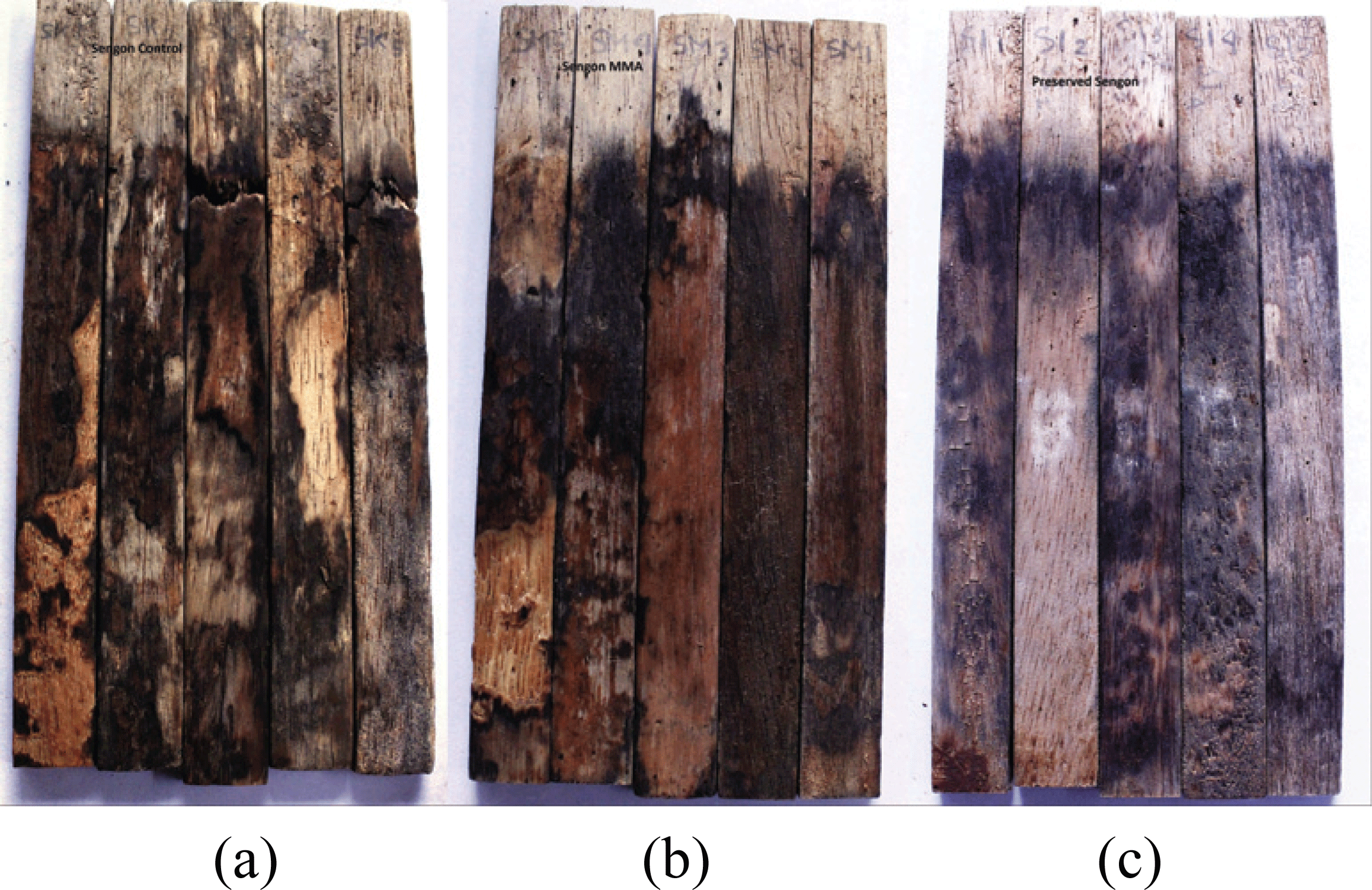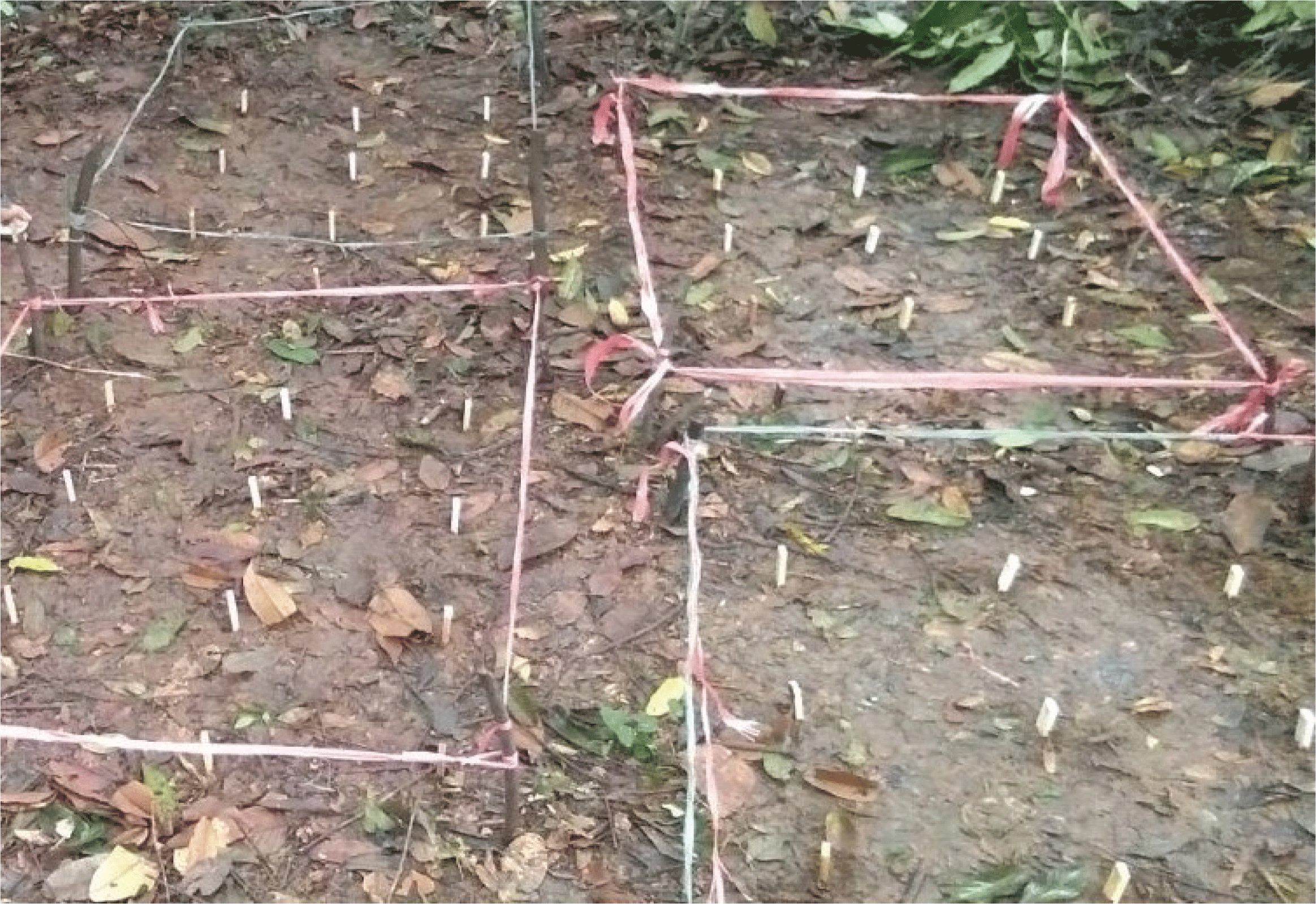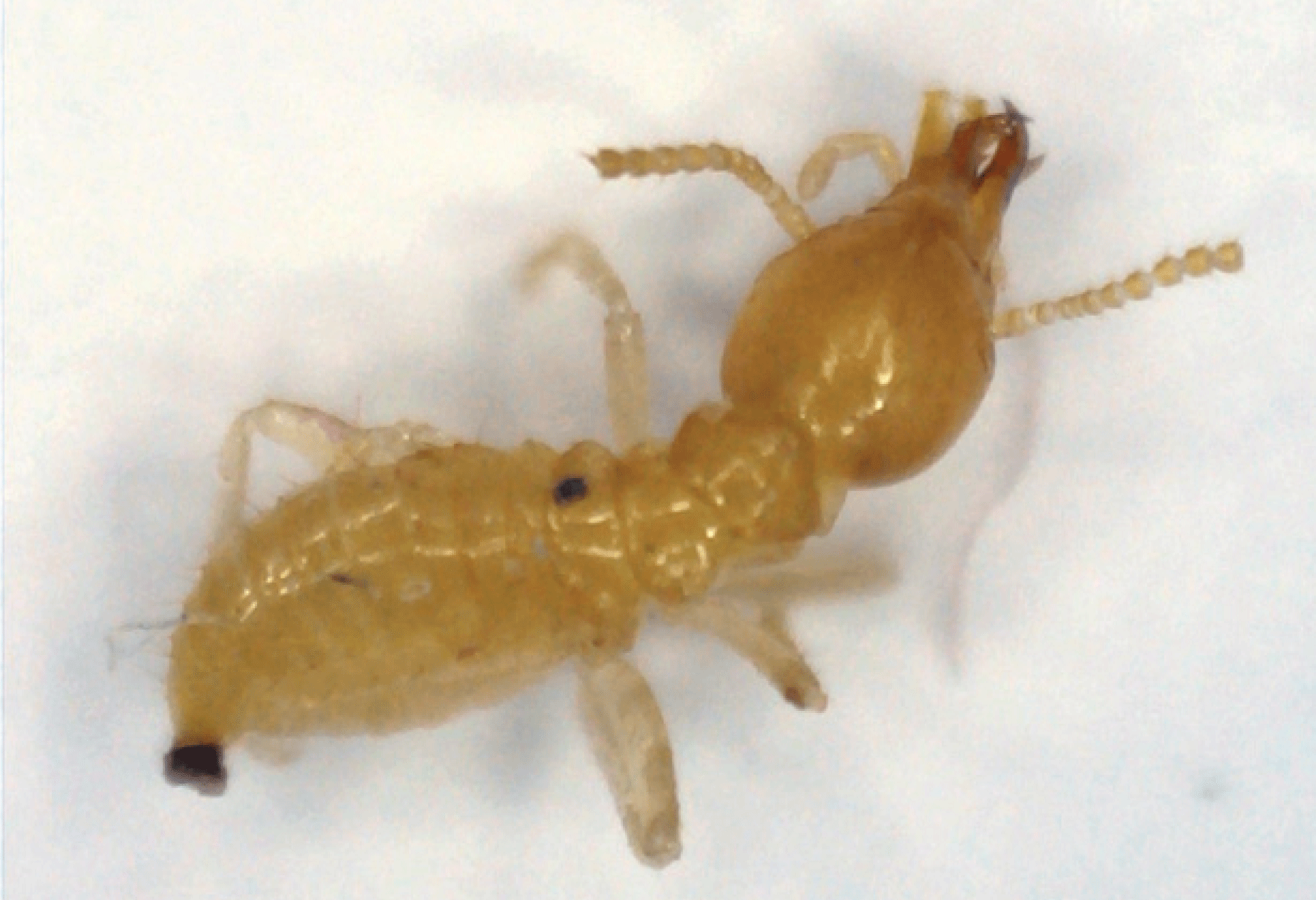1. INTRODUCTION
The Indonesian Ministry of Environment and Forestry reported that the supply of logs in 2016 reached 37.5 million m3, with 85% of the logs mostly being sourced from plantation forests which managed by governmental company, private forests belong to citizens, and government corporates with forest concession companies. The stands are mostly planted with fast-growing pioneer tree species, such as sengon (Falcataria moluccana), jabon (Anthocephalus cadamba), mangium (Acacia mangium), pine (Pinus merkusii), and gmelina (Gmelina arborea), and by 2016 the plantation forest reached 10 million hectares (Ministry of Environment and Forestry 2017).
The trees are mostly cut at 6–10 years of age, and the resulting timber predominantly contains sapwood and a lot of juvenile wood (Hadi et al., 2015a). Such timber has inferior physical and mechanical properties as well as less resistance to biodeterioration attack, particularly subterranean termite attack, compared to mature wood (Fajriani et al., 2013). Lee et al. (2017) reported that the heartwood of yellow-hearted pine (Pinus densiflora) was more resistant than sapwood against brown-rot fungi (Fomitopsis palustris), white-rot fungi (Trametes versicolor), and termites (Reticulitermes speratus). The susceptibility to biodeterioration not only affects solid wood from the fast-growing species, but is also present in derived products. For example, particleboard made from this timber is also susceptible attacked by termites (Hermawan et al., 2012).
To prolong the service life of timber, preservation by means of impregnating the wood with poisonous chemicals is undertaken. As reported by Fadillah et al. (2014), preserved mahogany (Swietenia sp) wood has much greater resistance to biodeterioration than untreated wood, and Hadi et al. (2015b) found that preserved mindi (Melia azedarach Linn) and sugi (Cryptomeria japonica D. Don) woods treated with borax had more resistance than untreated wood. Wood preservation makes the wood poisonous to organisms that attack it, but the chemicals may also be hazardous to humans as well as the environment. To avoid such side effects from the preservation process, another option for preventing biodeterioration is chemical modification of the wood. For example, impregnation of wood with methyl methacrylate (MMA) can improve the physical and mechanical properties of the wood as well as its durability.
Several chemical modification processes have been studied, and the results show that the products have better physical-mechanical properties and greater resistance to biodeterioration due to organisms that attack wood. Methods that improve resistance to biodeterioration attacks include acetylation of particleboard and fiberboard (Hadi et al., 1995; Rowell et al., 1997), polystyrene impregnation of wood (Hadi et al., 1998; 2016c; Abdul Khalil et al., 2014), MMA impregnation of wood (Kartal et al., 2004; Hisham and Anwar, 2005; Hadi et al., 2015a), furfuryl alcohol wood treatment (Hadi et al., 2005; Esteves et al., 2011), smoked wood (Hadi et al., 2010a; 2010b; 2012), smoked glulam (Hadi et al., 2016a; 2016b), polyurethane resins for non-biocidal wood preservation (Mubarok et al., 2017), binderless particleboard (Suhasman et al., 2012; Kusumah et al., 2017), and polyethylene glycol impregnation of bamboo tubes (Kang et al., 2017). Klüppel et al. (2015) concluded that higher polymer loading of impregnating resin and a higher percentage weight gain from acetylation or furfuryl alcohol impregnation of wood increased resistance to biodeterioration attack.
Hadi et al. (2008) reported that MMA-impregnated bamboo had much better physical and mechanical properties than untreated bamboo. In another study, Hadi et al. (2013) impregnated jabon wood with MMA and obtained an average polymer loading 34%. This MMA-impregnated wood had significantly enhanced physical and mechanical properties, as shown by the 7% lower moisture content, 17% lower volume shrinkage, 12% higher MOR, and 27% higher MOE compared to the untreated wood. Furthermore, Hadi et al. (2015a) found that MMA-impregnated jabon wood with an average polymer loading of 69% had better resistance to subterranean termites than untreated wood in laboratory tests. Compared to untreated wood, the MMA wood had less weight loss (77.7%), a lower termite feeding rate (73%), and increased termite mortality (20.9%).
Research on MMA-impregnated wood has mostly focused on physical and mechanical properties and has very seldom assessed termite attack resistance. In a previous study by Hadi et al. (2015a) on MMA-impregnated wood, MMA polymerization was induced with 60Co gamma radiation and the wood specimens underwent laboratory testing to assess resistance to termite attack. In the current study, MMA polymerization was induced with heat, and the wood specimens were exposed to termites through in-ground, or graveyard, tests. The wood samples included three types of hardwood (sengon, jabon, and mangium) and one type of softwood (pine). The purpose of the study was to determine the resistance of MMA-impregnated wood to subterranean termite attack using small clear specimens for in-ground tests. For purposes of comparison, samples of untreated wood and wood treated with a conventional preservation method were also prepared.
2. MATERIALS and METHODS
Sengon, jabon, mangium, and pine from Bogor, West Java, Indonesia, were used to determine the resistance of MMA-impregnated wood to subterranean termite attack in graveyard or in-ground tests. Wood specimens sized 0.8 cm thick by 2 cm wide by 20 cm long were used for testing. The samples were dried to reach 12% moisture content, weighed, and then placed under vacuum at 5 atmospheres for 30 minutes. Afterward, they were immersed in MMA monomer solution under pressure at 5 atmospheres for 30 minutes. Following removal from the impregnation apparatus, each wood sample was wrapped with an aluminum sheet and placed in an oven at 60 °C for 48 hours for MMA polymerization. Afterward, the aluminum was removed and the wood samples were weighed for calculating the polymer loading. The samples then underwent conditioning for 2 weeks.
For purposes of comparison, untreated and imidacloprid-preserved wood specimens with the same size were also prepared. The wood preservation process was applied to samples with 12% moisture content and initiated with 5 atmospheres vacuum for 30 minutes. During vacuum release, 3% imidacloprid was streamed into the tank, followed by 10 kg/cm2 pressure for 1 hour, and a 24-hour immersion process. The number of replication for each treatment was five.
To evaluate the resistance of the wood specimens to subterranean termite attack, in-ground testing was carried out in the arboretum of the Forestry Faculty, Bogor Agricultural University, Bogor, Indonesia. Each specimen was inserted vertically into the ground to half of its length, as shown at Fig. 1. The exposure period lasted for 3 months (SNI 2006). At the end of the test, the samples were oven-dried and their weights were measured. The weight loss percentage for samples was calculated using the following formula:
where W1=weight of the oven-dried sample prior to the test (g), and W2=weight of the oven-dried sample after the test (g).
To analyze the effect of treatments upon all responds, a 4 × 3 completely randomized design was used for data analysis. The first factor was wood species (i.e., pine, mangium, jabon, and sengon), and the second factor was treatment (i.e., untreated, MMA impregnation, and imidacloprid preservation). Duncan’s test was used for further analysis if a factor was significantly different at p ≤ 0.05.
3. RESULTS and DISCUSSION
A representative termite that attacked wood specimens is shown in Fig. 2. The species was identified as Coptotermes curvignathus Holmgren. Test specimens of sengon wood after 3 months of exposure are shown in Fig. 3.

Wood density affects how readily liquid can enter into wood tissue. Wood with a lower density is usually more easily penetrated by a monomer or chemical solution because there is more void space in its structure. In this study, the densities of sengon, jabon, mangium, and pine wood were 0.28, 0.34, 0.58, and 0.68 g/cm3, respectively. The MMA polymer loadings of sengon, jabon, mangium, and pine specimens were 27.88%, 24.91%, 14.14%, and 17.81%, respectively, and imidacloprid retentions were 7.56, 5.98, 5.34, and 9.53 kg/m3, respectively. The polymer loadings of MMA in this research was much lower than reached by Hadi et al. (2015), but the study was still carried out to know how much the resistance of MMA wood with this polymer loading value to subterranean termite attack in the field test. To get more polymer loading of MMA it should be suggested that it needs more time for vacuum and pressure during impregnation process.
Sengon wood had the highest MMA polymer loading and imidacloprid retention because it had the lowest density, The values for sengon were followed by those for the other two hardwoods, jabon and mangium. Pine had slightly higher values than mangium, although its density was higher. This finding can be explained by pine being a softwood that has simpler anatomical characteristics.
The weight loss percentages of each wood species along with their treatment are shown in Table 1, and the results of the analysis of variance is presented in Table 2.
As shown in Table 1, untreated mangium wood had the lowest weight loss. Mangium belongs to resistance class IV and had better resistance compared with the other wood species, which belong to class V. However, all untreated wood species were classified into the low resistance class with regard to subterranean termite attack (Hadi et al., 2016c). Based on the analysis of variance, all factors, namely, wood species, treatment, and interaction between the two factors, had a highly significant effect on the weight loss of specimens. Further, the results of Duncan’s tests indicated that the four wood species differed from one each other as did the three treatments. The most resistant wood was mangium, followed by pine, sengon, and jabon. Among the treatments, imidacloprid-preserved wood had the greatest resistance, followed by MMA-impregnated wood and untreated wood.
Further data analysis for the interaction of wood species and treatment showed that the treatment, namely, preservation with imidacloprid and impregnation with MMA, did not reduce the amount of weight loss for mangium wood. It could be suggested that preservative retention and MMA polymer loading into mangium wood should be higher to get treated wood much more resistant compared with untreated wood. In contrast, treated pine specimens did not differ from each other, but both MMA-impregnated pine and imidaclopridpreserved pine were different from untreated pine wood. In other words, both treatments had the same effectiveness in increasing pine wood resistance to subterranean termite attack. For the sengon and jabon wood, imidacloprid-preserved, MMA-impregnated, and untreated specimens were different from each other. The imidacloprid-preserved wood was the most resistant, followed by MMA-impregnated wood and untreated wood.
Hadi et al. (2015a) found that MMA-impregnated jabon wood had 78% less weight loss compared to untreated wood, but in the current work the reduction was only 13%. The difference could be explained by a higher MMA polymer loading (69%) and use of 60Co gamma radiation at 10 or 30 kGy for polymerization rather than heat in the previous study. To obtain better resistance to subterranean termites in MMA wood, when using heat in the polymerization process, higher polymer loading is needed. As reported by Ding et al. (2008), an increase in the degree of polymer loading affected physical and mechanical properties linearly in MMA-polymerized structures constructed from mature wood. Nevertheless, damage to these structures due to termite attack was associated with economic losses of five hardwoods and one softwood species and found that the density was enhanced by as much as 45% to 130% depending on species.
From the current study, it can be concluded that MMA impregnation of wood increased its resistance to subterranean termite attack during in-ground testing, but the resistance level was lower than that of imidacloprid-preserved wood. In future work, especially for MMA polymerization induced by heating, a clear goal is to obtain higher MMA polymer loading into the wood.
4. CONCLUSION
From this work, the following conclusions can be made:
The four untreated wood species all belonged to the low resistance class with regard to subterranean termite attack.
MMA impregnation of wood increased its resistance to subterranean termite attack during in-ground testing, but the resistance level was lower than that of imidacloprid-preserved wood. Further, for mangium wood, the treatment did not significantly improve resistance to attack.
In future work, especially for MMA polymerization induced by heating, higher MMA polymer loading into wood is needed.










